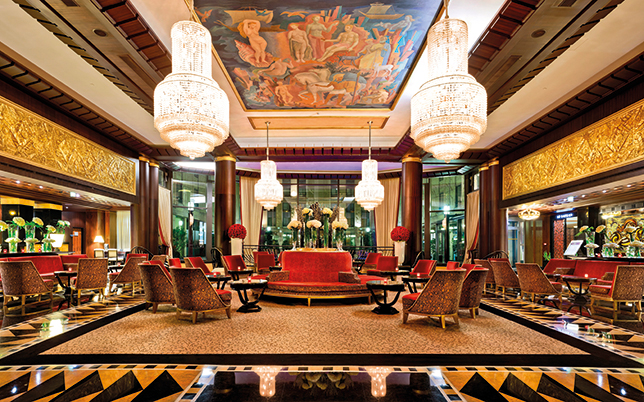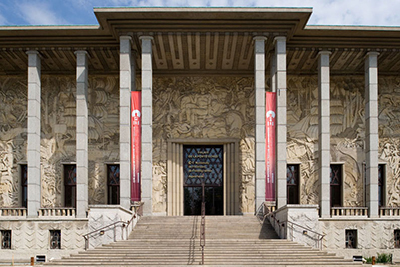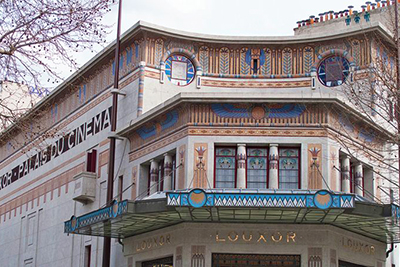
The Art Deco era officially began in Paris with the 1925 Exposition Internationale des Arts Décoratifs et Industriels Modernes (International Exposition of Modern Industrial and Decorative Arts). And though the City of Light was already home to some fabulous architecture prior to this world’s fair, the movement certainly took off. To discover all that Paris has to offer in terms of Art Deco, we spoke to Marion Beilin, marketing director at the ultimate Paris Art Deco star, L’Hotel du Collectionneur, who shared some of the top recommended spots on her list, which guests receive when staying at the hotel.
Art Deco dazzled the world in the 1920s, and paying homage to the movement that continues to seep through society today, the Palais de Chaillot (aka Cité Chaillot and Cité de l’Architecture) is hosting the exhibition 1925, Quand l’Art Déco Séduit le Monde (1925, When Art Deco Dazzled the World) that runs through March 3. An eye-opener into the evolution of this voguish movement, the palais, a symbol of Art Deco itself, is located right in the heart of Paris at the Trocadéro and looks across at the Eiffel Tower. Built for the 1937 Exposition Internationale des Arts et des Techniques Appliqués à la Vie Moderne (International Exposition of Art and Technology in Modern Life) to replace the old Trocadéro, Palais de Chaillot was where the United Nations General Assembly adopted the Universal Declaration of Human Rights in 1948, and in 1952 the building served as the initial NATO headquarters. Today, it is tied to the Cité de l’Architecture and acts as a venue for various exhibitions and functions.
 Beilin also suggests checking out the Palais de la Porte Dorée, which, although less central than Chaillot, is worth the detour to the southeastern part of Paris for any self-discerning Art Deco fiend. Its majestic bas-relief façade by French sculptor Alfred Janniot is one of the most impressive in Europe and is a prime example of Art Deco’s strong link to exoticism in France. The building was commissioned for the 1931 Paris Colonial Exposition, whose objective was to awaken a sense of colonialism in Parisians. The bas-reliefs of a fiercely hierarchical society convey a ruthless aim to show off the wealth in France’s colonies. The palais is now the Cité Nationale de l’Histoire de l’Immigration (the National Museum of the History of Immigration) — it also has several tropical aquariums showcasing more than 300 species in its basement.
Beilin also suggests checking out the Palais de la Porte Dorée, which, although less central than Chaillot, is worth the detour to the southeastern part of Paris for any self-discerning Art Deco fiend. Its majestic bas-relief façade by French sculptor Alfred Janniot is one of the most impressive in Europe and is a prime example of Art Deco’s strong link to exoticism in France. The building was commissioned for the 1931 Paris Colonial Exposition, whose objective was to awaken a sense of colonialism in Parisians. The bas-reliefs of a fiercely hierarchical society convey a ruthless aim to show off the wealth in France’s colonies. The palais is now the Cité Nationale de l’Histoire de l’Immigration (the National Museum of the History of Immigration) — it also has several tropical aquariums showcasing more than 300 species in its basement.
 Our favorite Art Deco spot, however, is the spectacular recently reopened Louxor Palais du Cinema in the unpolished neighborhood of Barbès. The grand structure stands tall and graceful, shining like a diamond in the rough. The cinema was built in 1921 by the architect Henry Zipcy and was the place to see “exotic” films, notably Indian and Arab titles. The Louxor became a nightclub in 1983 before closing down indefinitely five years later and falling into a state of disrepair. Its Egyptian pyramid-themed exterior is instantly recognizable and is visible from the elevated metro line. A veritable monument of Paris and a celebration of the city’s cultural diversity, the Louxor received a second life when it reopened to the public as a full-working cinema in April 2013. It has three beautiful screening rooms, where a range of artistic and foreign films are shown, and a bar and lounge, where exhibitions and events are hosted.
Our favorite Art Deco spot, however, is the spectacular recently reopened Louxor Palais du Cinema in the unpolished neighborhood of Barbès. The grand structure stands tall and graceful, shining like a diamond in the rough. The cinema was built in 1921 by the architect Henry Zipcy and was the place to see “exotic” films, notably Indian and Arab titles. The Louxor became a nightclub in 1983 before closing down indefinitely five years later and falling into a state of disrepair. Its Egyptian pyramid-themed exterior is instantly recognizable and is visible from the elevated metro line. A veritable monument of Paris and a celebration of the city’s cultural diversity, the Louxor received a second life when it reopened to the public as a full-working cinema in April 2013. It has three beautiful screening rooms, where a range of artistic and foreign films are shown, and a bar and lounge, where exhibitions and events are hosted.
Opened in 2004, L’Hotel du Collectionneur, a 10-minute walk from the Champs-Élysées, is also one of our favorites especially for its cruise-liner-meets-ballroom lobby of chevron-patterned marble floors, gold bas-reliefs, showy chandeliers and scarlet velvet circular banquette. Designed by Jacques Garcia and Alexandre Danan, the hotel is a celebration of 1930s glamour and luxury. Although the rooms are slightly toned down, the godfather of the French 1920s Art Deco movement, Jacques-Émile Ruhlmann (aka Émile-Jacques) is present on every headboard in the shape of an inversed version of his iconic chariot logo. For visitors who make it to the hotel before March 15, there’s a temporary Grand Vintage 2004 Moët & Chandon champagne bar to test out and Bruno de Lorgues’ black truffle dinners to sample as part of the hotel’s Bulle du Collectionneur (the collector’s bubble) events.
Other stars of the Art Deco movement recommended by the team at the hotel include Le Grand Rex, Salle Pleyel, Théâtre de la Michodière, Folies Bergère, Le Studio Building and Théâtre des Champs-Élysées. We would also add Fondation Le Corbusier, La Samaritaine, the lobby of the Prince de Galles hotel for a modern take on the movement, and for a crossover between Art Deco and Art Nouveau head to the Musée des Arts Décoratifs (Art Deco Museum).
Photos Courtesy of Hôtel du Collectionneur, Palais de la Porte Dorée and Louxor Cinéma Paris

